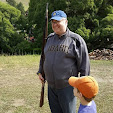Once the figures are painted, I affix flags, base, and flock them.
I almost always use GMB Design's flags. The quality is consistently excellent, and Graeme is a pleasure to deal with.
The Tools: clean cutting surface, metal straight edge, sharp hobby knife
GMB has little cutting guides, making precision cutting easy.
These flags have narrow white borders.
I use a little Glue-All to affix the flag to its staff. I let this dry for about five minutes.
Once the glue has become gummy, but has not completely set, I use toothpicks to create ripples in the flag. The first bend is parallel to the flag pole, and each subsequent bend becomes more horizontal.
Sprue cutters clip off any excess pole.
I always paint the edges of the flags so that the white paper does not show. These flags only need a spot of red where the flag meets the pole.
A little bit of gold on the tip, and my painting is done.
I am not sure what type of ink Graeme uses, but it sometimes fogs under a lacquer spray, so I assume it is mineral oil soluble. To keep it from fogging, I brush on this water based varnish.
I go through a lot of bases, so I find that prepping a few hundred at a time is a good idea. I use a scrap piece of lumber, blue painter's tape, and a flat brown enamel spray paint.
The enamel paint adheres well to the base sides, but its most important function is to create an impermeable barrier for the water based glue wash.
I always let the enamel dry outdoors for a few hours. If I move too fast, the bases stay gummy.
Here are 105 bases ready for troops.
In a commission with many variety of uniform, I will usually label each base by troop type.
I remove all the troops from their painting sticks and sort them by like poses. I find Elmer's Glue-All works very well to secure the figures to their bases. Because it is water soluble, rebasing only requires an overnight soak in a baking pan filled with water.
The Glue-All must set for at least 12 hours. After it is ready, I start the flocking. My dirt is Woodland Scenics Fine Brown Ballast.
The cheaper hobby acrylics contain more binder than pigment, which makes them slow drying. I use a medium sized brush to paint the entire base.
A quick swirl in the ballast is all they really need. I use my finger to wipe off the sides of the base.
Once the dirt is on all the bases, I apply a glue wash to the entire base. It's roughly one part Glue-All to five parts tap water.
This glue wash also needs to dry overnight. It dries hard, and as long as the enamel spray paint covered the entire base, the water will not warp the wood. This dirt will not fall off from casual handling of the figures. You have to put some real effort into taking any off.
I have a variety of turf that I use for different periods, seasons, and scales. The default is Gale Force 9's static grass. It looks great, and it's very easy to work with. I am not sure what they do differently, but the other brands feel coarser to the touch.
I use undiluted Glue-All and apply it in spots. I try to break up the sides of each figure's individual base.
I make a quick swirl in the static grass. Sometimes I will apply a little pressure with my fingertips to tamp the grass onto the base.
Once the figures are done, I let the glue dry for a few hours.
The last step involves sealing the figures. I have used a variety of techniques over the years, but the tried and true method is an application of Testor's Dullcote on a warm day.
I will have one more post in this series. Check in tomorrow!




































No comments:
Post a Comment